drtbear1967
Musclechemistry Board Certified Member
I grew up competing in Martial Arts and, of course, when you are a kid and teenager you play video games that go along with your interests. This means a lot of Street Fighter and Mortal Combat! I can remember always selecting Ryu and Ken in street fighter or Lui Kang in Mortal combat. What I remembered most was that they had great shoulders. That was the first time I really became fascinated with them. However, in bodybuilding and even bikini competition deltoids become very important. If you go back to the Greeks, a beautiful pair of shoulders would help emphasize or create the illusion of having a smaller waist. How do you build a beautiful pair of shoulders (Deltoids)? What are the secrets to unlocking this muscle groups majesty? This article will give you the keys to do this. This article will be presented in FAQ fashion.What is the Anatomy and Function of the Deltoids?
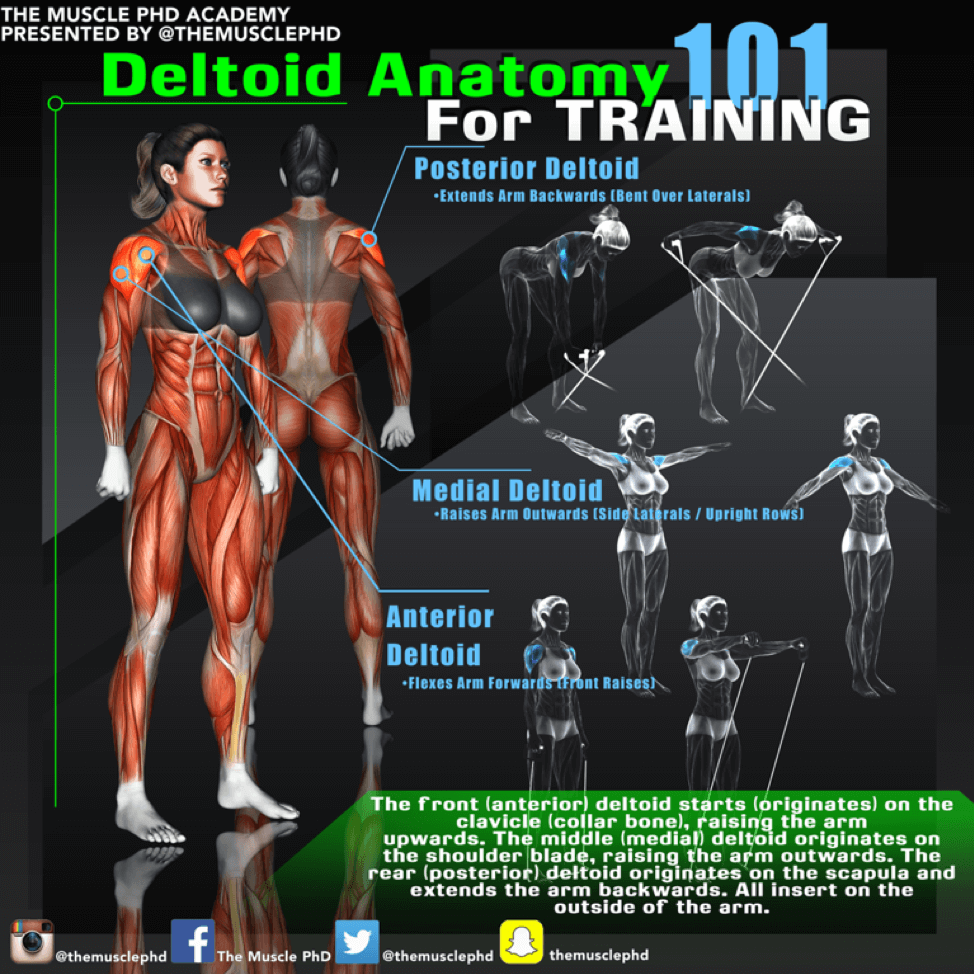
The deltoids can be divided into the front, side, and rear deltoids; this means they have 3 heads. The bones they originate on are the shoulder blade (scapula) and collarbone (clavicle). The deltoids insert onto the upper arm (humerus). The rear deltoid defines the shoulders from the back and fittingly attaches to the back of the shoulder blades and inserts on the upper arm. The side deltoid provides width to your shoulders and attaches to the upper part of the scapula and inserts on the upper arm. Finally, the front deltoid originates on the collarbone and inserts on the upper arm as well. Functionally the rear, side, & front deltoids move your arms back, out to the side, & forward respectively.
How Heavy Should I lift When Training The Deltoids?
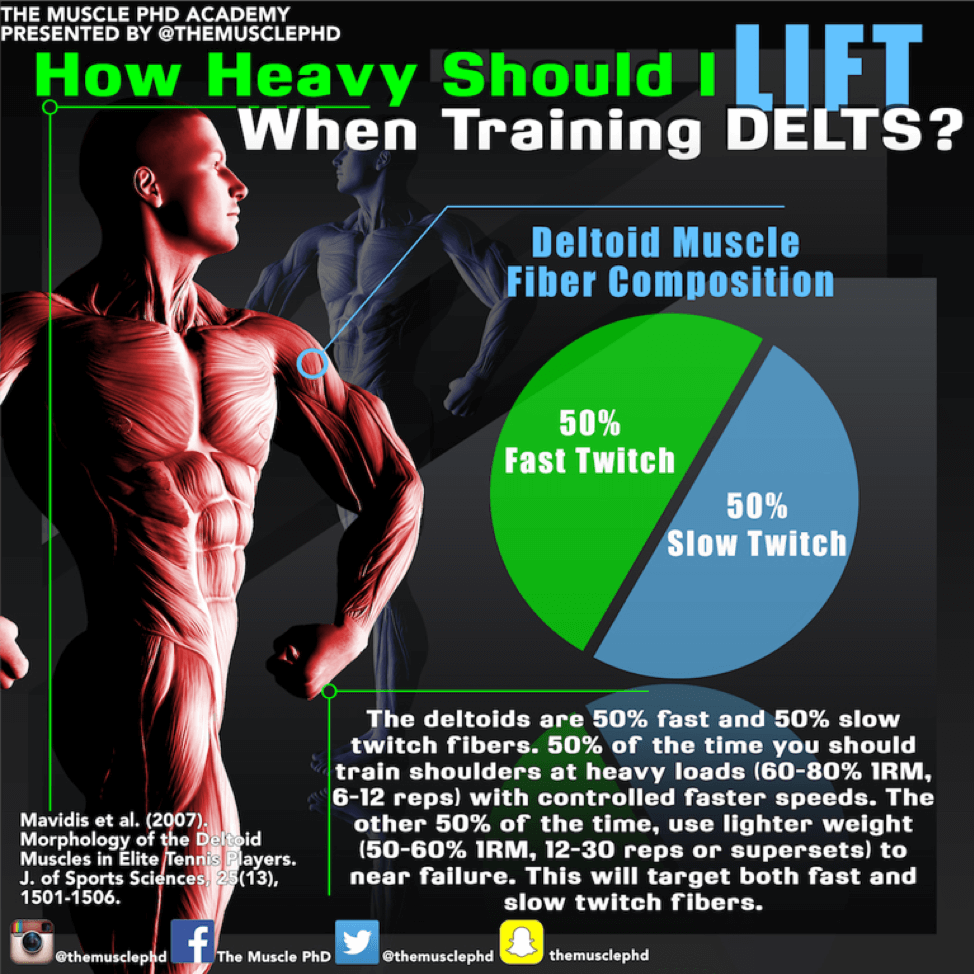
This is a difficult question. However, we can pull information from studies which look at muscle fiber makeup of the muscle group. Specifically, the deltoids average 50% fast and 50% slow twitch muscle fiber make up (Mavidis et al. 2007). This means that on average you should split your training up between heavier days (60-85 % 1RM for 6-12 reps) and lighter days (50-60 % of your 1RM for 12-30 reps).
Does Grip Width Impact Deltoid Growth?

Remember that the various heads of the deltoids have different functions. Specifically, the side deltoids main function is shoulder adduction. Again this means that it moves the arms out and to the side. Also, recall that the front deltoids flex the arms forward and upwards. As we all know the military press is a major mass builder when it comes to building the deltoids. How we perform this exercise impacts what head of the deltoid is emphasized. One study found that bringing the hands closer (shoulder width apart) caused more shoulder flexion and greater front delt activation during the military press (Ackland et al. 2008). This same study also found that a wide grip military press caused more shoulder abduction which increased activation of the side deltoids! Take home message is to use a close and wide grip when targeting front and side delts respectively.
What is Better? Standing or Seated Military Press?
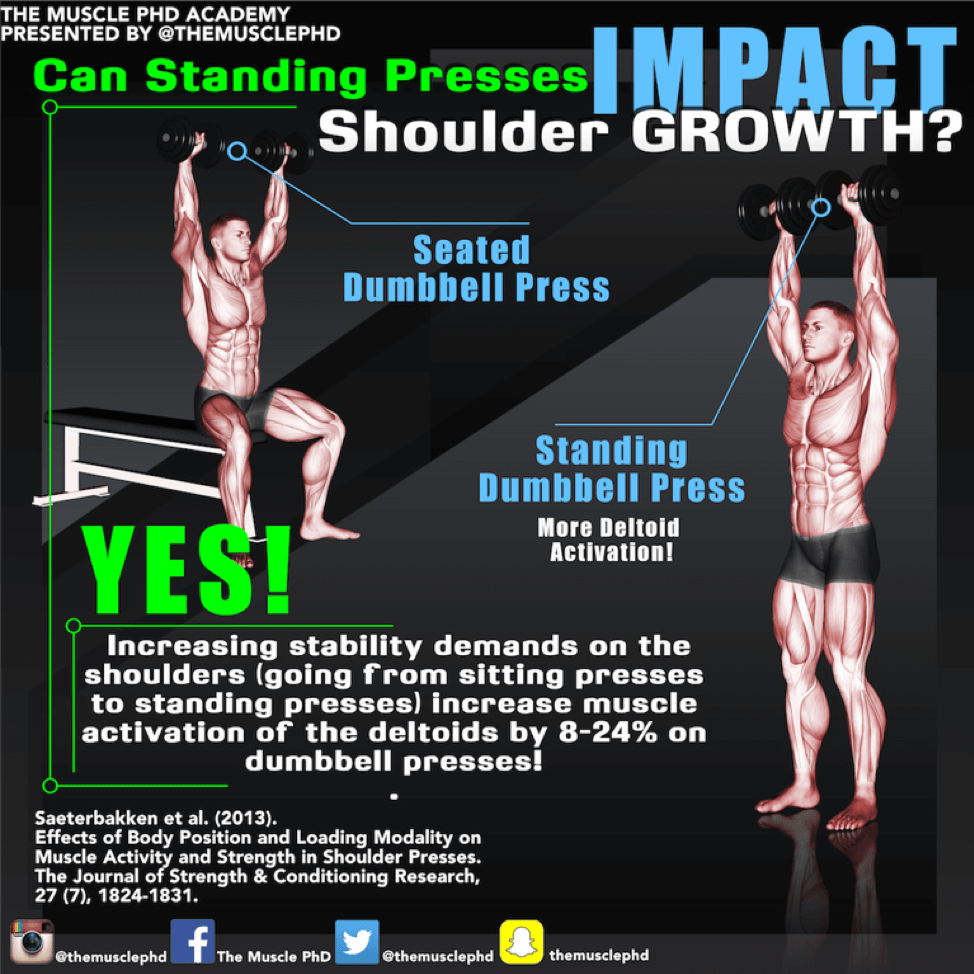
The deltoids also function to stabilize the shoulder joint. That being said an increase in stability demands of an exercise may increase delt activation. In fact, this study found that Increasing stability demands (going from seated to standing) on the shoulders increased muscle activation of the deltoids by 8-24 % on dumbbell presses (Saeterbakken et al. 2013)! Thus, standing presses can be a valuable tool in your training game!
What is a Better Exercise? Upright Rows or Military Press?
The answer is that both are great. Research shows that upright rows are better at targeting the side deltoids than military presses (McAllister et al. 2013). In contrast, military presses are better at targeting the front deltoids
Does Bench Angle Impact the Front Delts Activation?
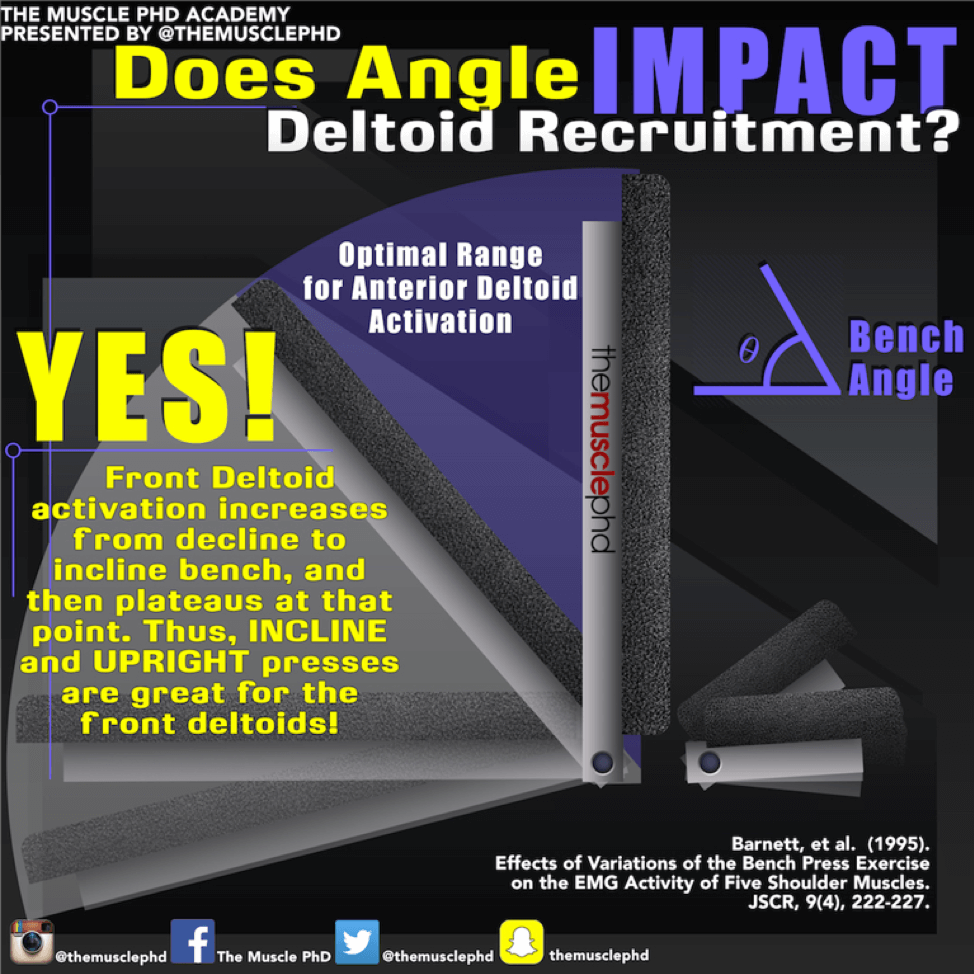
Yes! Research shows that on pressing movements that front delt activation increases as you move from decline bench to incline bench. However, after a steep incline (60 degrees) delt activation plateaus (Barnett et al. 2005). Realize, however, that when doing incline presses that chest activation increases. Thus, a great way to take advantage of this is to go to failure with military presses and then take the same weight and do incline presses after.
What Grip Should I take on Upright Rows for the Delts?
Research shows that a wide grip upright row causes greater abduction and thus greater side delt activation than close grip upright rows. Therefore for delt width select wide grip rows. It is interesting to note that the same study found close grip increased biceps activity. Thus, you could fail with wide grip upright rows and keep the set going with close grip upright rows (McAllister et al. 2013).
How Can you Optimize Tension in the Middle and Front Delts?
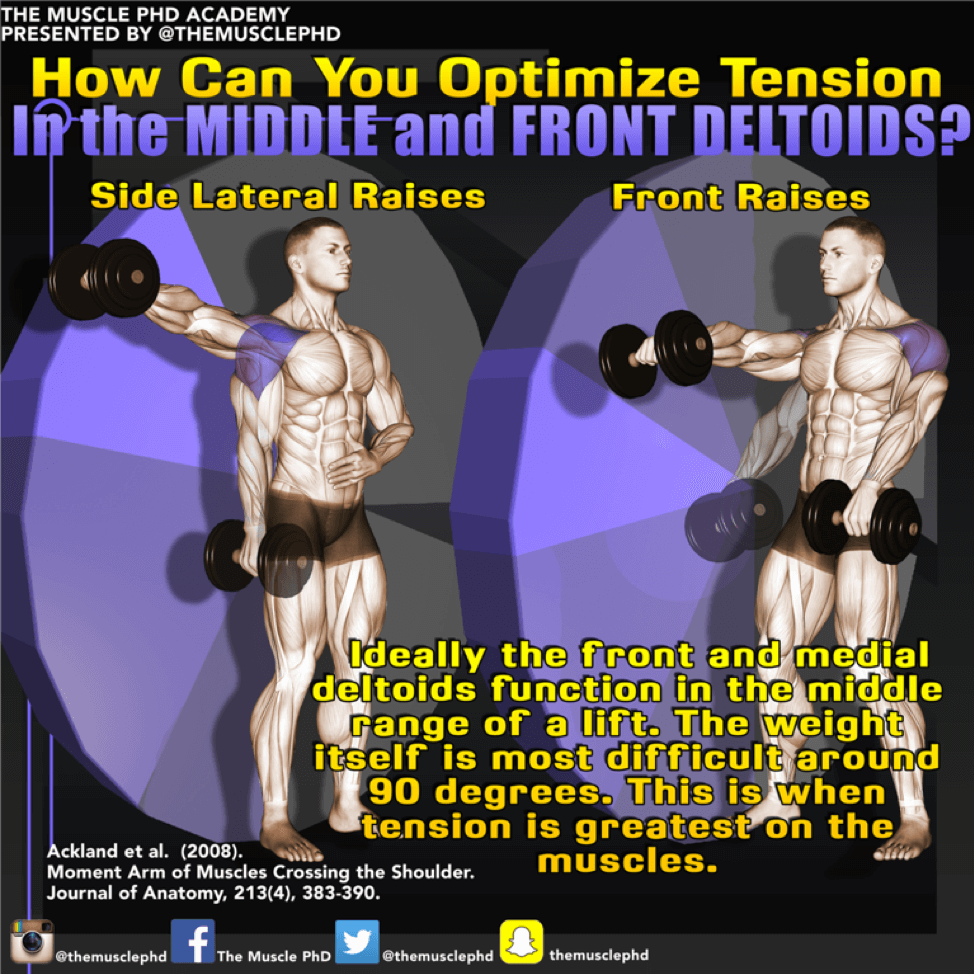
The front / anterior and middle deltoids are mechanically wired to function optimally around 60 to 120 degrees (arms above the eyes) on both front and side raise exercises. Given that the force of a weight is mechanically peaked at 90 degrees it would follow that focusing effort in the middle range of motion, with particular emphasis when the arm is parallel with the ground would optimize muscle activation (Ackland et al. 2008).
How Can You Optimize Tension in the Rear Delts?
The rear deltoids are mechanically wired to function optimally in the middle range of a horizontal lateral movement (Ackland et al. 2008). Dumbbells, however, peak in their line of force at the top range of motion, where the rear deltoids do not function well. For this reason, using cables or machines and stressing the middle range of motion can optimize rear deltoid growth.
Summary
The delts are an amazing muscle group. We learned a great deal in this article about how to optimize their training. Below is a bullet point breakdown of each of the lessons we covered.
• The deltoids consist of three parts: the anterior (front), medial (side), and posterior (rear) deltoids
• These muscles originate around the clavicles and scapula
• The front deltoids raise the arm upwards (shoulder flexion)
• The side deltoids raise the arm to the side (side laterals and upright rows)
• The rear deltoids extend the arm backward, particularly in a horizontal plane as in bent over laterals
• The deltoids are 50% fast and 50% slow. Thus, roughly half your training should be focused on each
• Wide grip and close grip presses hit the side and front deltoids respectively
• Standing movements activate the stability components of the deltoids and thus up muscle activation of the delts
• Upright rows and presses are ideal for side and front deltoids, respectively
• The bench angle, which optimizes front deltoid activation, is between incline and upright
• Upright rows are optimized with a wide rather than close grip
• On side and front raises the deltoids work ideally in the middle range of motion, with peak tension occurring when the dumbbell is parallel to the ground
• For bent over laterals tension of the dumbbell peaks at the top of the motion, but the muscle works best in the middle of the exercise. For this reason, cables optimize tension on rear deltoids
<!-- end article section --> <!-- Citations --> <section class="row padder-x-xs-top padder-x-side-sm margin-x-md-top white" id="tmphd-citations">Citations
Ackland, D. C., Pak, P., Richardson, M., & Pandy, M. G. (2008). Moment arms of the muscles crossing the anatomical shoulder. Journal of Anatomy, 213(4), 383-390.
Barnett, C., Kippers, V., & Turner, P. (1995). Effects of Variations of the Bench Press Exercise on the EMG Activity of Five Shoulder Muscles. The Journal of Strength & Conditioning Research, 9(4), 222-227.
McAllister, M. J., Schilling, B. K., Hammond, K. G., Weiss, L. W., & Farney, T. M. (2013). Effect of grip width on electromyographic activity during the upright row. The Journal of Strength & Conditioning Research, 27(1), 181-187.
Mavidis, A., Vamvakoudis, E., Metaxas, T., Stefanidis, P., Koutlianos, N., Christoulas, K., ... & Mandroukas, K. (2007). Morphology of the deltoid muscles in elite tennis players. Journal of sports sciences, 25(13), 1501-1506.
Saeterbakken, A. H., & Fimland, M. S. (2013). Effects of body position and loading modality on muscle activity and strength in shoulder presses. The Journal of Strength & Conditioning Research, 27(7), 1824-1831.
</section>

The deltoids can be divided into the front, side, and rear deltoids; this means they have 3 heads. The bones they originate on are the shoulder blade (scapula) and collarbone (clavicle). The deltoids insert onto the upper arm (humerus). The rear deltoid defines the shoulders from the back and fittingly attaches to the back of the shoulder blades and inserts on the upper arm. The side deltoid provides width to your shoulders and attaches to the upper part of the scapula and inserts on the upper arm. Finally, the front deltoid originates on the collarbone and inserts on the upper arm as well. Functionally the rear, side, & front deltoids move your arms back, out to the side, & forward respectively.
How Heavy Should I lift When Training The Deltoids?

This is a difficult question. However, we can pull information from studies which look at muscle fiber makeup of the muscle group. Specifically, the deltoids average 50% fast and 50% slow twitch muscle fiber make up (Mavidis et al. 2007). This means that on average you should split your training up between heavier days (60-85 % 1RM for 6-12 reps) and lighter days (50-60 % of your 1RM for 12-30 reps).
Does Grip Width Impact Deltoid Growth?

Remember that the various heads of the deltoids have different functions. Specifically, the side deltoids main function is shoulder adduction. Again this means that it moves the arms out and to the side. Also, recall that the front deltoids flex the arms forward and upwards. As we all know the military press is a major mass builder when it comes to building the deltoids. How we perform this exercise impacts what head of the deltoid is emphasized. One study found that bringing the hands closer (shoulder width apart) caused more shoulder flexion and greater front delt activation during the military press (Ackland et al. 2008). This same study also found that a wide grip military press caused more shoulder abduction which increased activation of the side deltoids! Take home message is to use a close and wide grip when targeting front and side delts respectively.
What is Better? Standing or Seated Military Press?

The deltoids also function to stabilize the shoulder joint. That being said an increase in stability demands of an exercise may increase delt activation. In fact, this study found that Increasing stability demands (going from seated to standing) on the shoulders increased muscle activation of the deltoids by 8-24 % on dumbbell presses (Saeterbakken et al. 2013)! Thus, standing presses can be a valuable tool in your training game!
What is a Better Exercise? Upright Rows or Military Press?
The answer is that both are great. Research shows that upright rows are better at targeting the side deltoids than military presses (McAllister et al. 2013). In contrast, military presses are better at targeting the front deltoids
Does Bench Angle Impact the Front Delts Activation?

Yes! Research shows that on pressing movements that front delt activation increases as you move from decline bench to incline bench. However, after a steep incline (60 degrees) delt activation plateaus (Barnett et al. 2005). Realize, however, that when doing incline presses that chest activation increases. Thus, a great way to take advantage of this is to go to failure with military presses and then take the same weight and do incline presses after.
What Grip Should I take on Upright Rows for the Delts?
Research shows that a wide grip upright row causes greater abduction and thus greater side delt activation than close grip upright rows. Therefore for delt width select wide grip rows. It is interesting to note that the same study found close grip increased biceps activity. Thus, you could fail with wide grip upright rows and keep the set going with close grip upright rows (McAllister et al. 2013).
How Can you Optimize Tension in the Middle and Front Delts?

The front / anterior and middle deltoids are mechanically wired to function optimally around 60 to 120 degrees (arms above the eyes) on both front and side raise exercises. Given that the force of a weight is mechanically peaked at 90 degrees it would follow that focusing effort in the middle range of motion, with particular emphasis when the arm is parallel with the ground would optimize muscle activation (Ackland et al. 2008).
How Can You Optimize Tension in the Rear Delts?
The rear deltoids are mechanically wired to function optimally in the middle range of a horizontal lateral movement (Ackland et al. 2008). Dumbbells, however, peak in their line of force at the top range of motion, where the rear deltoids do not function well. For this reason, using cables or machines and stressing the middle range of motion can optimize rear deltoid growth.
Summary
The delts are an amazing muscle group. We learned a great deal in this article about how to optimize their training. Below is a bullet point breakdown of each of the lessons we covered.
• The deltoids consist of three parts: the anterior (front), medial (side), and posterior (rear) deltoids
• These muscles originate around the clavicles and scapula
• The front deltoids raise the arm upwards (shoulder flexion)
• The side deltoids raise the arm to the side (side laterals and upright rows)
• The rear deltoids extend the arm backward, particularly in a horizontal plane as in bent over laterals
• The deltoids are 50% fast and 50% slow. Thus, roughly half your training should be focused on each
• Wide grip and close grip presses hit the side and front deltoids respectively
• Standing movements activate the stability components of the deltoids and thus up muscle activation of the delts
• Upright rows and presses are ideal for side and front deltoids, respectively
• The bench angle, which optimizes front deltoid activation, is between incline and upright
• Upright rows are optimized with a wide rather than close grip
• On side and front raises the deltoids work ideally in the middle range of motion, with peak tension occurring when the dumbbell is parallel to the ground
• For bent over laterals tension of the dumbbell peaks at the top of the motion, but the muscle works best in the middle of the exercise. For this reason, cables optimize tension on rear deltoids
<!-- end article section --> <!-- Citations --> <section class="row padder-x-xs-top padder-x-side-sm margin-x-md-top white" id="tmphd-citations">Citations
Ackland, D. C., Pak, P., Richardson, M., & Pandy, M. G. (2008). Moment arms of the muscles crossing the anatomical shoulder. Journal of Anatomy, 213(4), 383-390.
Barnett, C., Kippers, V., & Turner, P. (1995). Effects of Variations of the Bench Press Exercise on the EMG Activity of Five Shoulder Muscles. The Journal of Strength & Conditioning Research, 9(4), 222-227.
McAllister, M. J., Schilling, B. K., Hammond, K. G., Weiss, L. W., & Farney, T. M. (2013). Effect of grip width on electromyographic activity during the upright row. The Journal of Strength & Conditioning Research, 27(1), 181-187.
Mavidis, A., Vamvakoudis, E., Metaxas, T., Stefanidis, P., Koutlianos, N., Christoulas, K., ... & Mandroukas, K. (2007). Morphology of the deltoid muscles in elite tennis players. Journal of sports sciences, 25(13), 1501-1506.
Saeterbakken, A. H., & Fimland, M. S. (2013). Effects of body position and loading modality on muscle activity and strength in shoulder presses. The Journal of Strength & Conditioning Research, 27(7), 1824-1831.
</section>
Last edited:

